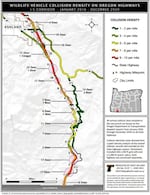A crossing near the Oregon-California border would help keep deer, elk and other wildlife from becoming roadkill on the side of the interstate.
This section of road essentially splits up major wild areas, including the Cascade-Siskiyou National Monument, leading to an increased number of wildlife encounters.

This undated artist's rendering shows the design of an overpass crossing for wildlife spanning above four lanes of traffic on I-5, looking southeast. Construction on the overpass is expected to begin in 2028 in the Cascade-Siskiyou National Monument in Southern Oregon, less than two miles north of the California border.
Oregon Department Of Transportation
The Oregon Department of Transportation reported that along with over a hundred collisions with deer, at least five bears and one cougar were hit along the stretch from Ashland to the California Border between 2016 and 2020.
Their reporting doesn’t include the many small animals, like raccoons, squirrels, skunks and more that go unreported.
A coalition of nonprofits and government agencies have been working to design and build an overpass near the Cascade-Siskiyou National Monument, where animals are more likely to cross the highway.
The wildlife overpass would be designed in a way that animals wouldn’t even know they’re crossing over a highway, shielded from lights, vibration and views of traffic. Fencing would also be installed on either side to guide animals towards the crossing.

A map showing the density of collisions with wildlife on I-5 between Ashland the the California border from 2016 through 2020.
Oregon Department Of Transportation
Amy Amrhein is one of the coalition’s coordinators. She said ODOT is asking for $20 million from a new federal wildlife crossing pilot program, adding around $115 million is available for this year.
“So we have asked for a big chunk of that money, but we are cautiously optimistic that Oregon has a very viable project on an interstate in a national monument with high levels of wildlife-vehicle collisions,” Amrhein said.
Out of eight potential sites, Amrhein said they’ve narrowed it down to the best one for a wildlife overpass, called Mariposa Preserve. She said that’s the most likely spot for an overpass because it would bridge two sections of federal land, and the site is fairly straight.
ODOT is currently in the design and engineering phase of the project. The agency received $1.5 million in state funding for the design, which comes from a $7 million fund approved by the state legislature.
Amrhein said along with a wildlife overpass, her group is looking at potential places to improve two existing underpasses to create more places for wildlife to cross, located at Niel Creek and the Mt. Ashland exit.
“Both can be improved, and we have recommendations for ODOT to – for much less cost – improve those underpass locations so they’re a little bit more accessible and attractive to wildlife to get them off the side roads,” Amrhein said.
She said adding additional safe crossings is needed, because this is a 14-mile section of highway. It would be difficult to convince animals to walk miles to use the bridge overpass, Amrhein said.
The group is expecting the federal funding to be announced early next year. If their funding is approved, construction could begin in 2025 or 2026.